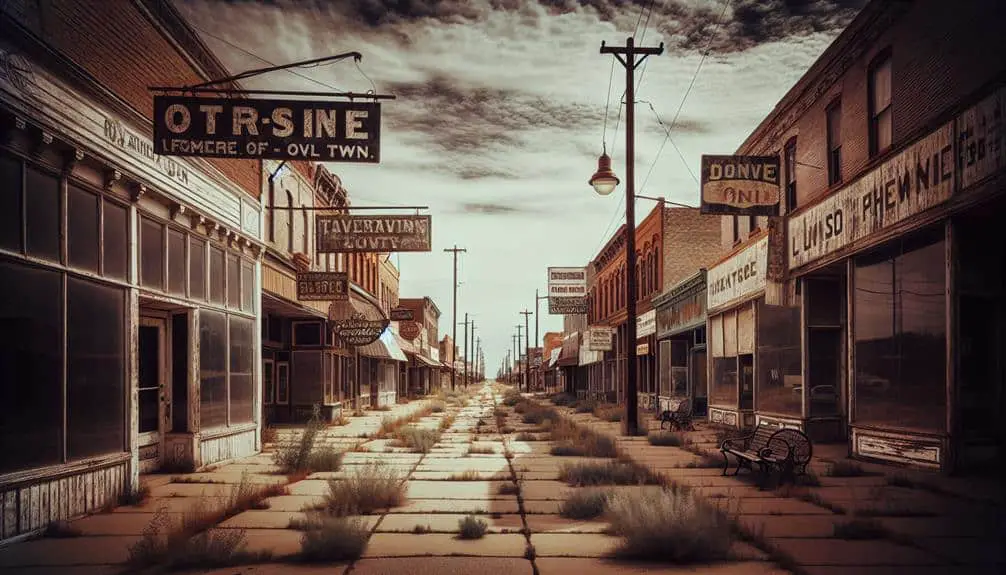Explore the eerie remnants of abandoned oil towns, witnessing the rise and fall of once-booming communities. Investigate the architectural gems that echo tales of prosperity and industry. Uncover the industrial relics left behind, showcasing a haunting beauty in decay. Discover the challenges of preserving these historical sites amidst environmental concerns. Reveal the tourism potential within these ghost towns, breathing new life into forgotten landscapes. The forgotten America's past echoes through these towns, waiting to disclose more mysteries and stories of resilience and transformation.
Key Points
- Industrial relics in abandoned towns showcase economic activities and the haunting beauty of decay.
- Historic oil town architecture reflects resilience, grandeur, and stories of ambition.
- Challenges of preserving oil towns include environmental impact and balancing remediation with historical authenticity.
- Boom and bust cycles shape oil towns' destiny, impacting communities profoundly.
- Tourism potential in ghost towns offers economic revitalization, job opportunities, and heritage preservation.
Boom and Bust of Oil Towns
In the cycle of prosperity and decline, oil towns experience rapid growth and sudden abandonment due to the volatile nature of the industry. Economic cycles play a pivotal role, shaping the destiny of these communities.
When oil prices soar, these towns thrive, attracting droves of workers seeking employment and opportunity. As businesses flourish, the community booms, with new infrastructure and services cropping up to meet the demands of the burgeoning population. However, this prosperity is often short-lived.
When oil prices plummet, these once-thriving towns can quickly turn into ghost towns. The impact on the community is profound. Jobs vanish, businesses close, and families are uprooted in search of new opportunities. The social fabric that once held the town together begins to fray, leaving behind a landscape marred by abandoned buildings and a sense of loss.
The economic rollercoaster of oil towns underscores the delicate balance between growth and decline, leaving a lasting imprint on the communities it touches.
Historic Oil Town Architecture
Amidst the desolate landscape of abandoned oil towns lie remnants of a bygone era, showcasing the resilience and grandeur of historic oil town architecture. Oil town landmarks such as the ornate facades of old company headquarters, the towering derricks that once dotted the horizon, and the charming worker cottages paint a vivid picture of a time when these towns thrived with activity. The architectural preservation techniques used in some of these abandoned structures offer a glimpse into the past, revealing the craftsmanship and attention to detail that went into their construction.
Exploring these architectural wonders can transport you back to a time when oil was king and these towns were bustling with life. From the elegant Victorian-style mansions of oil barons to the modest yet sturdy homes of the laborers, each building tells a story of ambition, hard work, and the pursuit of the American dream. By studying these architectural gems, you gain a deeper appreciation for the history and heritage of these once-prosperous communities.
Industrial Relics in Abandoned Towns
Among the remnants of abandoned oil towns, one can uncover fascinating industrial relics that offer a glimpse into the once-thriving economic activities that shaped these communities. As you explore these forgotten areas, you'll witness the haunting beauty of industrial decay, where rusted machinery stands as silent witnesses to a bygone era. Urban exploration enthusiasts are drawn to these sites, seeking to capture the essence of a time when these towns bustled with life and industry.
The industrial relics you encounter tell stories of hard work, ingenuity, and progress. From towering smokestacks to dilapidated warehouses, each structure holds a piece of history waiting to be discovered. As you navigate through these abandoned sites, you can almost hear the echoes of machinery and the shouts of workers that once filled these streets.
Amidst the rubble and overgrowth, there's a sense of both melancholy and awe. The industrial decay serves as a reminder of the impermanence of human endeavors, while also offering a glimpse into the resilience of these communities in the face of change. Explore these abandoned towns with a sense of reverence for the past and a curiosity for the stories they hold.
Challenges of Preserving Oil Towns
Steering the endeavor of preserving oil towns poses intricate challenges that demand strategic planning and innovative solutions to safeguard these historical sites for future generations. The environmental impact left by the oil industry in these towns adds a layer of complexity to preservation efforts. Contaminated soil, water sources, and air quality issues require specialized cleanup and restoration processes to guarantee the safety of both the environment and any potential visitors.
Community engagement is another vital aspect of preserving oil towns. Involving local residents, historical societies, and conservation groups in the decision-making process can help foster a sense of ownership and pride in the preservation efforts. It's essential to create partnerships with stakeholders who've a vested interest in maintaining the integrity of these sites.
Balancing the need for environmental remediation with the desire to maintain the historical authenticity of the oil towns is a delicate task. Finding sustainable solutions that address both concerns is key to ensuring that these remnants of America's industrial past are protected and celebrated for years to come.
Tourism Potential in Ghost Towns
Revealing the mysterious riches of deserted oil towns, their vibrant history, and potential for tourism offers a mesmerizing journey into the past and a unique opportunity for exploration and discovery. Ghost town photography allows you to capture the eerie beauty of abandoned buildings, rusty machinery, and forgotten streets frozen in time. These snapshots not only preserve the visual essence of these ghost towns but also serve as a window into the lives of the people who once inhabited these places.
Economic revitalization through tourism can breathe new life into these forgotten communities by attracting visitors enthusiastic to immerse themselves in the stories and legends of the past. By transforming ghost towns into tourist destinations, local businesses can thrive, creating job opportunities and preserving the heritage of these once-bustling settlements.
Frequently Asked Questions
What Impact Did the Boom and Bust of Oil Towns Have on the Local Economy and Population?
You thought the oil boom would bring prosperity, but it left a trail of abandoned towns. The economy crumbled, people left, and the once vibrant communities turned into ghost towns, echoing a forgotten past.
Are There Any Unique Architectural Features Specific to Historic Oil Towns That Set Them Apart From Other Types of Abandoned Towns?
In historic oil towns, unique architectural features like company-built housing, industrial structures, and urban planning geared towards efficiency can be seen. Preservation efforts aim to capture the essence of these towns.
What Types of Industrial Relics Can Be Found in Abandoned Oil Towns and What Significance Do They Hold in Understanding the Town's History?
Investigating industrial relics in deserted oil towns exposes a treasure trove of cultural artifacts that recount the town's history. These remnants, from machinery to buildings, provide insight into the environmental impact and community heritage, showcasing a rich tapestry of stories.
What Are Some of the Main Challenges That Come With Preserving Oil Towns and How Are Organizations Working to Address Them?
Preservation efforts face challenges like funding shortages and lack of public interest. Community engagement becomes essential in raising awareness and rallying support. Organizations work tirelessly to bridge gaps, ensuring these historic oil towns remain part of our heritage.
How Has the Tourism Potential in Ghost Towns Evolved Over the Years and What Are Some of the Factors That Contribute to Their Appeal to Visitors?
As tourism evolved, ghost towns became cultural gems. Their allure lies in the allure of history frozen in time. Visitors seek adventure in the remnants of forgotten lives, drawn by the mystery and nostalgia of abandoned places.



